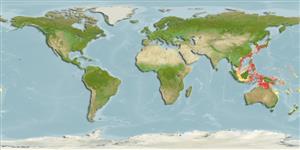Classification / Names
Common names from other countries
Main reference
Size / Weight / Age
Max length : 40.0 cm TL male/unsexed; (Ref. 90102)
Environment
Marine; reef-associated, usually 8 - 50 m (Ref. 27115)
Climate / Range
Subtropical; 23°C - 28°C (Ref. 27115), preferred ?
Distribution
Short description
Dorsal
spines
(total): 13;
Dorsal
soft rays
(total): 7;
Anal
spines: 3;
Anal
soft rays: 10. Body anterior to wedge in adults somewhat dusky, paler posteriorly. Body with an anteroventrally angled narrow dusky wedge extending from base of tenth or eleventh dorsal-fin spine to posterior side of pectoral-fin base. Scales on subopercle reaching to or nearly to below anterior extent of ventral preopercular edge; predorsal scales reaching nearly to above posterior extent of orbit on dorsal midline of head (somewhat short of this in very large specimens). Juveniles somewhat mottled, but with a faint indication of above pattern and an ocellated dark spot posteriorly on dorsal fin.
IUCN Red List Status (Ref. 115185)
Threat to humans
Harmless
Human uses
Aquarium: commercial
More information
ReferencesAquacultureAquaculture profileStrainsGeneticsAllele frequenciesHeritabilityDiseasesProcessingMass conversion
Tools
Special reports
Download XML
Internet sources
Estimates of some properties based on models
Phylogenetic diversity index
PD50 = 0.5000 many relatives (e.g. carps) 0.5 - 2.0 few relatives (e.g. lungfishes)
Trophic Level
3.5 ±0.37 se; Based on food items.
Resilience
Medium, minimum population doubling time 1.4 - 4.4 years (Preliminary K or Fecundity.)
Vulnerability
Moderate vulnerability (42 of 100)
Price category
